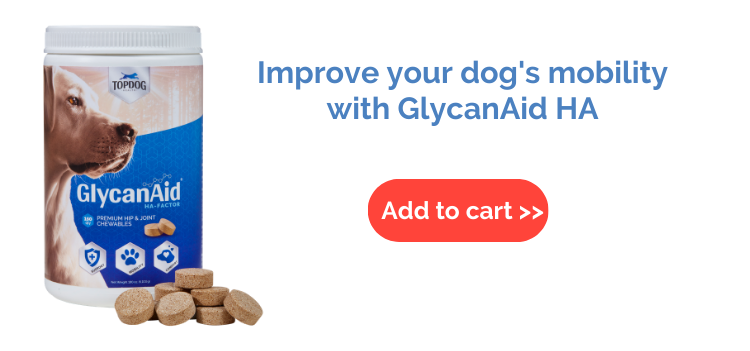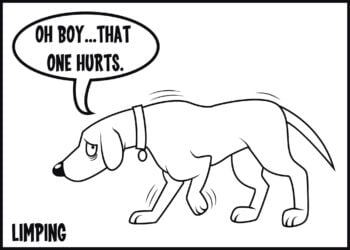If your dog is suffering from joint pain, you may have heard that glucosamine can help. Glucosamine is one of the most popular supplements for canines (and with good reason), but because of this, all the information out there can feel overwhelming.
So to help you out, we’ve done the work and compiled all the essentials in one place.
Here’s your complete guide to glucosamine for dogs.
What Is Glucosamine?
In a nutshell, glucosamine is a naturally occurring compound made of glucose (a sugar) and glutamine (an amino acid) that is essential for maintaining healthy cartilage and joint function. A building block of the cartilage matrix, it stimulates the growth of cartilage cells and has also been known to normalize the synovial fluid which lubricates joints.
Glucosamine is naturally produced by your dog’s body, but over time, their natural production becomes inadequate at preventing joint damage and must be supplemented. If you have a dog suffering from arthritis, joint supplements containing glucosamine (which is usually derived from certain shellfish such as shrimp, oysters, or crabs) help boost their reserve of this crucial nutrient. While glucosamine is not a cure for degenerative joint disease, it can help your dog feel more comfortable and stay mobile longer.
What Are the Benefits of Glucosamine for Dogs?
Dog joint supplements containing glucosamine can have tremendous benefits for your dog’s joint health. Overall, research indicates that glucosamine:
- Helps lubricate your dog’s joints for less painful movement
- Reduces inflammation in the joints (chronic inflammation is the #1 enemy of healthy joints)
- Improves overall joint health for increased mobility
Here’s how it works: In both dogs and humans, our bone ends are covered by a thin layer of spongy cartilage, which acts as a shock absorber. In addition, around the bone and cartilage is a liquid called synovial fluid that serves as a lubricant, making joint movement easy and pain-free.
As arthritis sets in, the cartilage and synovial fluid break down due to the trauma or pressure, causing your dog’s stiff gait or discomfort when moving. Over time, the bone-on-bone rubbing can cause bony outgrowths to develop on the bone ends, making movement even more difficult and painful for your beloved pet.
Here’s where glucosamine comes in. Glucosamine supplements help to stimulate cartilage growth and thicken synovial fluid, improving mechanical joint function and slowing the progression of arthritis – meaning less stiffness and discomfort for your dog. This is why glucosamine supplements can help many dogs resume their normal (or close to it) activity levels, as they are no longer dealing with constant, chronic pain.
Does My Dog Need Glucosamine?
Glucosamine is an essential component for pet parents who want to help alleviate the pain and discomfort associated with canine arthritis. Arthritis is a degenerative joint disease characterized by joint inflammation, leading to loss of joint mobility, stiffness, and lameness. The beginnings of arthritis can be triggered by an acute event, such as an injury or an infection, or they can be caused by an underlying problem such as joint deformity or excess stress on the joints from your dog being overweight. Either way, the issue compounds over time and symptoms start to emerge as your pet ages.
Here are some of the symptoms of canine arthritis to look out for:
Stiffness or limping (this may increase in the morning or during cold weather)
Slowness or reluctance to stand
Problems climbing stairs
Problems getting into or out of a car
Loss of interest in walks and exercise
Click here for the entire list of signs of arthritis.
While glucosamine is essential for dogs suffering from arthritis, it’s also important to note that glucosamine can be effective as a preventative measure as well, helping to slow the potential progression of degenerative joint disease in younger dogs with healthy joints. As we mentioned, your dog’s body’s ability to produce glucosamine on its own slows over time, so keeping their reserve healthy before symptoms occur can save them a world of pain.
Does Glucosamine for Dogs Work?
Glucosamine has been used to treat arthritis and joint pain in humans for decades, but a dog’s body is different. Luckily, several studies have found that supplementing dogs with glucosamine helped to revitalize the state of their joints. In particular, a 2007 study looked at 16 clinical trials to conclude that glucosamine supplements were as effective as several prescription drugs at bringing pain relief to canine patients. Another study that reviewed clinical trials conducted between the 1960s and 1999 found that the overall results indicated glucosamine has beneficial results for patients as well.
What Is the Best Glucosamine to Give My Dog?
Oral supplements are the most popular way that pet parents give glucosamine to dogs. While glucosamine is available as an injectable supplement, it can be quite expensive and time-consuming. Because of its popularity, some kibble brands have also been adding glucosamine to their senior or joint support foods, but unfortunately, the levels are typically too low to provide any benefit (your dog would have to eat A LOT of kibble).
Oral supplements come in the form of chewable tablets, liquids, or powder. What matters most here is what your dog prefers and will be willing to take regularly, as all oral forms of glucosamine are effective.
What matters is what other ingredients are present in the oral supplement, in addition to glucosamine.
When choosing a glucosamine supplement, here are the other ingredients you should make sure are included:
 Chondroitin
Chondroitin
Chondroitin sulfate is also found naturally in your dog’s body and works together with glucosamine to give them, even more, mobility and flexibility. Chondroitin is a cartilage component that promotes water retention (hydration is key for healthy joints) and elasticity needed for mobility. It also inhibits cartilage-destroying enzymes that break down cartilage and joint fluid. Look for Chondropure® which has a low molecular weight molecule for superior uptake.
 MSM
MSM
Methylsulfonylmethane (or MSM) is naturally occurring, easily-absorbed sulfur that is an essential building block for all cell membranes. In a nutshell, it is a cell rejuvenator, antioxidant, and joint healer. Highly effective at relieving pain and inflammation, it is unfortunately left out of the majority of dog joint supplements. TopDog’s joint supplement GlycanAid contains OptiMSM®, which is the only patented, 99.9% pure, premium distilled MSM on the market and is an easy way to provide your dog with this incredible nutrient.
 Vitamin C (Ascorbic Acid)
Vitamin C (Ascorbic Acid)
Ascorbic acid helps your dog digest and process the glucosamine more efficiently (as well as the other ingredients in a joint supplement). Unlike humans, dogs’ bodies can create their own vitamin C, but dogs with joint problems need more than what their bodies produce naturally. This antioxidant protects against free radicals that accelerate the aging process and aids in the absorption of the other ingredients. (Look for Easter-C® which is non-acidic and four times stronger than ordinary vitamin C).
Other ingredients can benefit your dog tremendously, for example, hyaluronic acid found in TopDog’s GlycanAid HA joint supplement, which is a gel-like substance that acts as a shock absorber and lubricates joint fluid – wonderful for dogs needing the highest level of joint support.
But these are the 4 ingredients that should be in your dog’s joint supplement: glucosamine, chondroitin, MSM, and ascorbic acid.
How Much Glucosamine Does My Dog Need?
To give you a general idea, dogs need approximately 500 mg of glucosamine per 25 pounds of body weight per day. However, if you decide to give your dog a glucosamine supplement, we always recommend speaking with your veterinarian to determine the best dosage and schedule for your dog, as they will take into account many factors including your dog’s weight, breed, age, the severity of symptoms, etc.
Is Glucosamine for Dogs Safe?
Luckily, glucosamine in any form doesn’t have many side effects for dogs. The main thing to look out for is that they don’t have an allergic reaction to the supplement itself. Symptoms of an adverse reaction could include vomiting/diarrhea, fatigue, trouble sleeping or breathing, or increased urination and thirst. If you notice any of these issues, bring your dog to the veterinarian right away.
Should I Give My Dog Glucosamine?
The bottom line is that glucosamine can make a world of difference for a dog suffering from joint pain, and has very few risk factors. Now that you’re informed, take this knowledge to your veterinarian to have an educated discussion about your options. You are the #1 advocate for your pet – their health and happiness are in your hands.









 Chondroitin
Chondroitin MSM
MSM Vitamin C (Ascorbic Acid)
Vitamin C (Ascorbic Acid)







